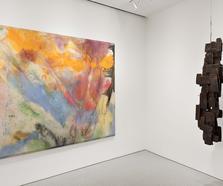“I use the spiral as a political icon—a wish for life and continued growth for all people. My tools are window wiper blades, Golden's Clear Tar Gel, Saunder's 300lb rag paper, Jade glue and Golden's Liquid Acrylic Paint. . . . Abstraction allows my paintings to speak directly to the art. My paintings are feelings and wishes. They are the embodiment of all I am and all that I have experienced.”[1]
A daring artist who continually changed his materials, methods, and style, Alvin Demar Loving, Jr. was born in Detroit in 1935. His father was a trained artist and educator who worked part time as a sign painter, was a founding faculty member at the University of Michigan at Flint, and eventually became a dean at the University of Michigan’s School of Education at Ann Arbor. Loving began his art education early, copying the drawings and watercolors in his father’s portfolios. While his father had artistic training, his mother and grandmother were exceptional quilters, and Loving would often watch as they sewed, transforming disparate scraps of cloth into unified, ordered patterns. Loving attended Detroit’s Northern High School, where he took every art class available and painted sets for school plays. Once he had exhausted the art opportunities at Northern, Loving transferred to Cass Technical High School, which offered a commercial art curriculum. After high school, Loving eventually started college at the University of Illinois, earning a BFA in 1963 before receiving his MFA from the University of Michigan two years later. In 1968, he moved to New York.
In New York, Loving developed “the image with which he became identified, an illusionary cube made out of prismatic color planes in dark, middle, and light values, edged with narrow, zinging, separating, black or white lines. The original inspiration was Josef Albers’ square, but Loving turned it into more of a crystalline structure.”[2] Within a year of his arrival in New York, Loving had a solo show at the Whitney Museum of Art. The 1969 Alvin Loving: Paintings was immensely successful; critics like Dore Ashton placed Loving’s work directly in the context of modernist art in a transitional moment from abstract expressionism to op art and other minimalist approaches.[3] In the wake of the Whitney show, Loving began receiving commissions for work. In fact, his paintings were selling so well, he needed to hire studio assistants.[4] But despite encountering the kind of almost-overnight success more typically achieved in movies, Loving was troubled by the disconnect between the crisp lines and geometrical detachment of his art and the engagement of social and political movements around him: “I felt stuck inside that box . . . I mean, this was 1968 — the Democratic convention, this was the war — and I’m doing these pictures. The contradiction between my life at that time and these pictures.”[5]
In the 1970s, attempting to free himself from what had become a signature style, Loving began destroying his hard-edged cube paintings and stitching the torn strips of canvas together to create large-scale, brightly colored geometric compositions, an action that echoed the quilting he had studied as a child. Like the earlier paintings from which they were made, these new works existed at a point of convergence between the two-dimensional and the three-dimensional. But the 1960s paintings created spatial tensions through line and color that pushed and pulled within the illusion of a third dimension on a flat surface, whereas the stitched-canvas works made the sculptural speak to the painterly, invoking collage along the way. In addition to canvas collages, Loving also began piecing together torn strips of paper and cardboard into massive compositions that he would paint in a variety of colors and mount to metal supports so that they jut out from the wall, causing shadows that in effect became part of the overall composition. In a New York Times review of a 1974 exhibition of these collages, Peter Schjeldahl described them as “enormously complicated works . . . As collage, they involve one in the pleasures of juxtaposed bits and pieces of raw material. As paintings, they are activated by the play of colors and visible brushstrokes . . . As dynamically composed reliefs . . . they energize the space around them, seemingly almost to be caught in the act of moving across the wall.”[6]

